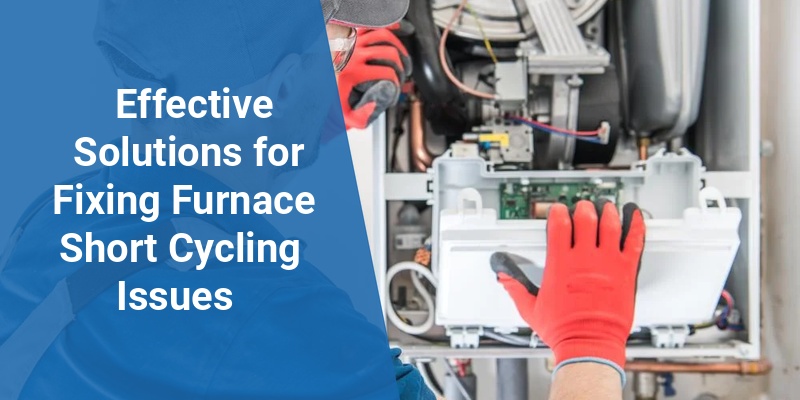Furnace short cycling is a common problem where the furnace turns on and off frequently, causing inefficient heating and increased energy costs. This issue can be frustrating for homeowners trying to maintain a comfortable temperature. Understanding the causes and solutions for short cycling can help improve furnace performance and extend its lifespan.
| Cause | Symptoms | Common Fixes |
|---|---|---|
| Dirty Air Filter | Frequent shutdowns, poor airflow | Replace or clean the filter regularly |
| Incorrect Thermostat Placement | Rapid temperature changes, frequent cycling | Relocate thermostat or recalibrate |
| Oversized Furnace | Short heating cycles | Consider furnace resizing or zoning |
| Blocked Vents or Ducts | Uneven heating, short cycling | Clear obstructions, clean ducts |
| Faulty Limit Switch | Quick shutdowns to prevent overheating | Replace the limit switch |
What Is Furnace Short Cycling and Why Does It Occur?
Furnace short cycling occurs when a furnace repeatedly turns on and off in short intervals rather than running for a continuous period to evenly heat a space. This behavior wastes energy, strains components, and reduces furnace lifespan. Short cycling often signals underlying issues such as airflow problems, mechanical faults, or system mismatches.
Key factors contributing to short cycling include dirty air filters restricting airflow, incorrect thermostat settings or locations, oversize furnaces that heat spaces too quickly, clogged vents or ducts that disturb air distribution, and malfunctioning internal components like limit switches.
Common Causes of Furnace Short Cycling
Dirty or Clogged Air Filters
A primary cause of short cycling is dirty air filters. When filters become clogged, airflow reduces drastically. This restriction can cause the furnace to overheat quickly, triggering the system’s safety mechanisms to shut it down prematurely.
Thermostat Placement and Settings
Improper thermostat placement—such as near heat sources, drafts, or direct sunlight—can cause inaccurate temperature readings, making the furnace cycle more frequently than necessary. Incorrect settings, particularly aggressive temperature differentials, also contribute.
Inappropriately Sized Furnace
An oversized furnace heats a home too fast, causing it to shut off prematurely without adequately circulating warm air. This oversizing results in short, inefficient cycles that increase wear and tear.
Blocked or Closed Air Vents and Ductwork Problems
Airflow blockages caused by closed or blocked vents or damaged ducts disrupt heat circulation, leading the furnace to overheat and shut down repeatedly.
Call 888-906-9139 for Free Local HVAC Quotes – No Obligation, Just Savings!
Faulty Limit Switch or Other Mechanical Failures
The limit switch monitors furnace temperature and shuts the system off if it gets too hot. A malfunctioning switch can incorrectly detect overheating, causing frequent cycle interruptions. Other mechanical issues like blower motor failures also cause short cycling.
How to Diagnose Furnace Short Cycling
Effective diagnosis involves a systematic approach to pinpoint the cause:
- Check and Replace Air Filters: Inspect filters for dirt or blockage and replace if necessary.
- Inspect Thermostat Setup: Verify thermostat placement and recalibrate or move it as needed.
- Measure Airflow: Assess vents and ductwork for blockages or leaks.
- Observe Furnace Operation: Monitor cycle duration and note if it’s stopping prematurely.
- Test Limit Switch and Components: Use professional tools to test switch functionality and other furnace parts.
If diagnosing these issues isn’t straightforward, consulting a professional HVAC technician is recommended for accurate assessment and repair.
Practical Furnace Short Cycling Fixes
Regular Filter Maintenance
Replacing or cleaning air filters every 1-3 months ensures optimal airflow and prevents overheating. High-efficiency filters improve indoor air quality while supporting proper furnace function.
Thermostat Adjustment and Replacement
Relocating the thermostat away from heat sources or drafts helps ensure accurate readings. Upgrading to a programmable or smart thermostat allows better control over cycles, reducing unnecessary cycling.
Matching Furnace Size to Home Requirements
Proper sizing during installation or replacement prevents short cycling. For existing oversized systems, adding zoning or variable speed blowers can help manage heating distribution more efficiently.
Clearing Blocked Vents and Repairing Ducts
Keeping vents open and clearing obstructions ensures balanced airflow. Routine duct cleaning and sealing prevent leaks that compromise heating efficiency.
Call 888-906-9139 for Free Local HVAC Quotes – No Obligation, Just Savings!
Replacing Faulty Mechanical Parts
If issues persist, professional repair may involve replacing the limit switch, blower motor, or other malfunctioning components to restore normal cycling.
Energy and Cost Benefits of Fixing Furnace Short Cycling
Addressing short cycling significantly improves energy efficiency, lowering utility bills by reducing unnecessary furnace startups and shutdowns. It also minimizes wear on furnace parts, extending equipment life and reducing costly repairs or early replacement.
Homeowners benefit from consistent indoor temperatures and fewer comfort complaints when furnaces operate smoothly without short cycling.
Signs You Need Professional Furnace Repair
When basic maintenance does not resolve short cycling, or if you notice additional problems such as strange noises, furnace failure to ignite, or irregular airflow, seek professional HVAC service. Experts can perform in-depth diagnostics and make precise repairs that ensure safe and efficient operation.
Preventative Tips for Avoiding Furnace Short Cycling
- Maintain regular filter changes and clean vents.
- Schedule annual furnace inspections and tune-ups with a licensed technician.
- Ensure proper thermostat placement and upgrade if necessary.
- Monitor your furnace cycles seasonally and address any irregularities promptly.
- Seal duct leaks and maintain consistent airflow to optimize furnace performance.
